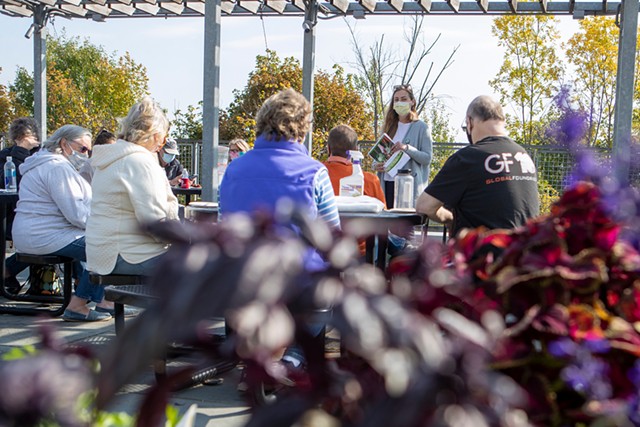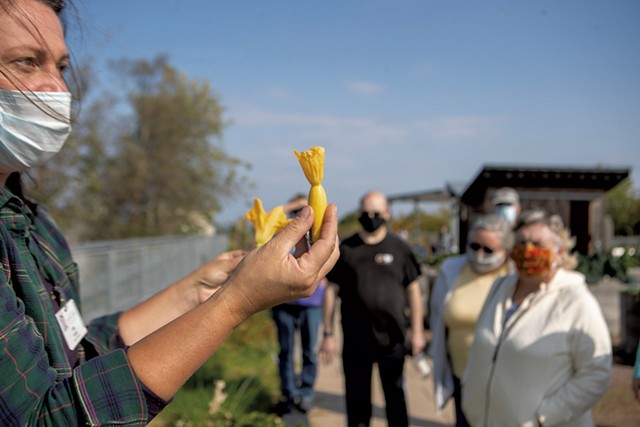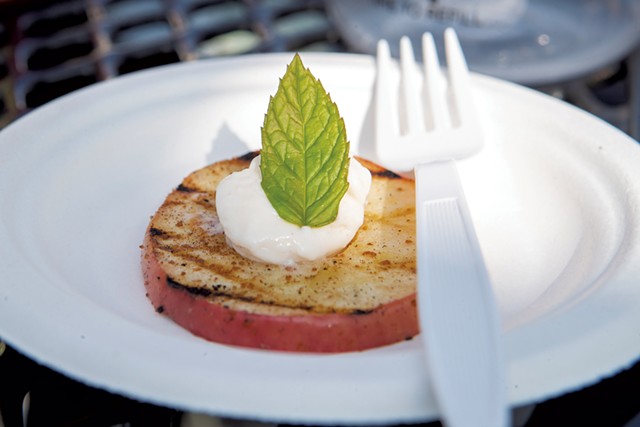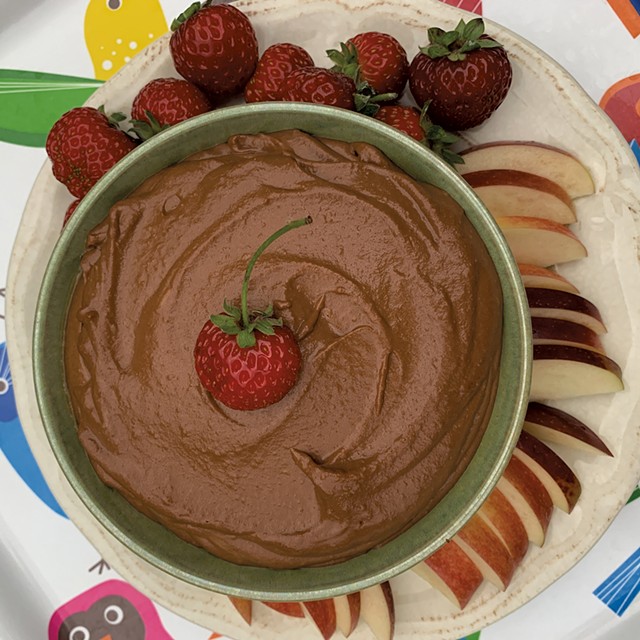The rooftop garden at the University of Vermont Medical Center is an unexpected oasis on top of a concrete and steel structure. On a late September morning, within view of the hospital’s grand entrance, bees buzzed among bright-blue borage flowers and scarlet bee balm. Sunlight shone through translucent crimson Swiss chard stems. A raised bed of Savoy cabbages bloomed like giant green roses.
“I feel like a Cabbage Patch Kid is going to pop out of one,” said Lisa Hoare, the medical center’s garden educator, laughing. She had been weeding while waiting to start the final meeting of the inaugural eight-week Gardening for Health program.
A blackboard on the garden shed wall read, “Welcome, gardeners! Today’s class: organic pest & weed control.” As the 14 participants gathered on the rooftop, they helped themselves from a cooler of ice water that was flavored with watermelon chunks and lime slices.
Hoare kicked off the meeting by asking how the preceding week’s suggested home activity, quick pickling, had gone.
One participant had made bread-and-butter refrigerator pickles; another had tried a provided recipe for three-bean salad. “It didn’t even get all the way pickled before we ate it all,” she said.
After some discussion of unexpected garden produce that could be pickled (unripe cherry tomatoes, chard stems), the group chatted about raised-bed construction and how to deal with tomato-loving woodchucks. Then Hoare led participants through a gentle stretching routine.
The Gardening for Health curriculum includes meditation and light physical activity along with vegetable gardening, nutrition and cooking activities. It was developed by the UVM Medical Center and the Vermont Community Garden Network, and the pilot year is supported by a grant from the medical center’s foundation. (Due to the pandemic, the June/July session planned for this year was bumped to 2021. The August/September session ran as scheduled.)
The program is free to all participants who qualify based on preexisting health conditions, including pre-diabetes, diabetes, high blood pressure and being overweight.
Vegetable gardening checks a lot of positive health boxes: It produces foods that everyone should eat more of, gets people outside and gives them more control over what they eat.
“Gardening and nutrition and culinary education are so closely linked,” said Hoare. “When people grow their own food, they have a closer connection to it and eat more of it. It’s fresher, better for you, and it tastes better.”
A key program goal, she continued, is “giving people the culinary skills to make healthy food taste delicious … It’s not about wagging fingers. It’s about empowering people.”
Homegrown produce can save money, too, especially compared with the organic options in a grocery store, Hoare added. Gardening can also provide social connections.
During the August/September Gardening for Health session, 56 participants, divided into four groups, planted Swiss chard seedlings and radish seeds. They learned how to prune tomato plants and add more legumes to their diet. They grew microgreens at home and shared observations from exploring their neighborhoods.
One participant, Leslie Kaigle, 62, arrived a little late to the final meeting after walking over from her chemotherapy appointment at the hospital. “I have a couple cancers,” she said matter-of-factly.
While Kaigle said she has always loved growing flowers and has several fruit trees and berry bushes at her home in Vergennes, vegetable gardening was new to her.
“I would like to know more where my food’s coming from,” she said. “I never had Swiss chard before, and I really love it.”
Asked how she would prepare it, Kaigle said she’d probably sauté the chard, add it to fresh tomato sauce with garlic, and serve it with white beans and penne pasta.
“I’m definitely vegetable gardening next summer, and chard will definitely be on the list,” she said enthusiastically.
Gardening for Health was born out of a growing recognition within the medical community that routine health care should include active support of healthy habits, including better eating habits.
In addition to Hoare, the project leaders are Michelle Gates, executive director of the Vermont Community Garden Network, who coleads the meetings; and Michael Latreille, a primary care doctor at UVM Medical Center. A physical therapist and a registered dietitian are also involved, and both medical and nutrition students from UVM contributed to a participant booklet filled with information, activities and recipes.
After several years of working with hospitalized patients, Latreille said it became clear to him that a significant percentage of the issues putting people in the hospital were preventable. Those include cardiovascular disease leading to heart attacks, strokes and high blood pressure, as well as type 2 diabetes.
“We spend a lot of time fixing problems,” Latreille said, noting that the root causes of those problems should be given more attention. In many cases, he added, “our efforts [would be] better spent in prevention than in treatment.
“I felt compelled to help people change habits that help them live their healthiest lives,” the physician explained.
Gardening for Health builds on existing programs, including the Learning Garden program at UVM Medical Center’s Fanny Allen campus, which Hoare has run for several years, and the Vermont Community Garden Network’s Community Teaching Garden at the Ethan Allen Homestead.
During the September morning meeting, Hoare encouraged the group to taste flower petals from the borage and bee balm. “Edible flowers are a super-fun thing to grow,” she said, suggesting that they can be tossed into salads. Gates said she likes to fold them into Vietnamese-style summer rolls, in which they show through the rice-paper wrappers. “We eat with our eyes,” Hoare said.
Gates grilled up the recipe of the day while Gretchen Berry, a UVM Medical Center registered dietitian based at Fanny Allen, shared healthy eating tips including fruit-centered desserts.
Everyone received a grilled apple slice sprinkled with cinnamon, brown sugar and a touch of salt and served with a dollop of vanilla bean Greek yogurt and a mint leaf.
Salt, Berry explained, can be “a really powerful tool to enhance the sweetness and reduce the need for sugar. A little goes a long way.”
The group brainstormed other fruits that could be grilled, including peaches and pineapple, and ways to include vegetables in desserts, such as beet brownies and zucchini or carrot cakes. Berry explained how to substitute applesauce for oil in muffins and quick breads. Hoare mentioned that she sometimes adds butternut squash to apple crisp and shredded zucchini and applesauce to chocolate cake.
Berry reminded everyone of how much she loves legumes and referenced a favorite chocolate hummus recipe (see sidebar). She emphasized that to sustain improved eating habits, “It’s about adding things, not taking them away.”
Deprivation often backfires by creating cravings; eating more of the good stuff leaves less room for less-healthy items, Berry said. Healthy fats, whole grains, beans and other legumes, and nuts and seeds “give us staying power, help us feel satisfied and keep blood sugar more stable,” she said.
During the discussion of vegetables for dessert, participant Wrigley Witmer of South Burlington mentioned one of his favorite recipes: carrot and sweet potato pie.
As the meeting wound down, Witmer, 37, happily filled a couple of bags with chard he had planted, plus some carrots and spinach. He shared that he has Ehlers-Danlos syndrome, a connective tissue disorder, and described himself as overweight.
“I’m trying to find healthy ways to lose weight while also trying to be as self-sufficient as possible,” Witmer said. “This [program] has definitely given me a little more confidence and tools for gardening.”
Linda Menard, 69, recounted that she had cultivated a huge garden until health problems prevented her from tending it. “It was a tremendous loss,” she said.
Menard credited the Gardening for Health program with restarting her interest in gardening. As a senior, she said, it helped her see how she could overcome physical and financial limitations. She especially appreciated the potted herbs and seeds each participant had received.
“It’s amazing what you can do with herbs,” Menard continued, describing a salad she had made with a “honey-lemon-parsley-oregano-basil-chive” dressing and seeds for crunch and a nutrition boost. “You can start small,” she noted.
Berry, the dietitian, said the program makes healthy eating tangible and approachable. “We miss something in nutrition when we focus just on nutrients,” she said. “This brings nutrition and the food system full circle. It helps people understand where their food comes from and how to grow and prepare their own food.”
Chocolate Hummus
Adapted from a recipe by Leah Pryor, executive chef, University of Vermont Medical Center
Ingredients
- 1 (15-ounce) can chickpeas, drained and rinsed
- ⅓ cup tahini
- ⅓ cup extra virgin olive oil
- ⅓ cup water
- 2 tablespoons maple syrup
- 1 teaspoon pure vanilla extract
- 4 ounces bittersweet chocolate, melted
Directions
- Place chickpeas, tahini, olive oil, water, maple syrup and vanilla extract in the bowl of a food processor. Process, scraping down the sides of the bowl as needed, until smooth.
- With the processor running, add the melted chocolate and process until smooth, again scraping down the sides as needed. Serve with fresh fruit or spread on toasted whole-grain bread. Makes about 2 1/2 cups hummus.
Note: The chocolate makes hummus set up fairly hard when chilled. Microwave it briefly at low power and stir aggressively to soften it.






